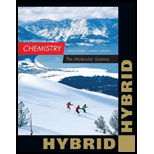
Concept explainers
(a)
Interpretation:
The molarity of the solute
Concept introduction:
Molarity (M): Molarity is number of moles of the solute present in the one liter of the solution.
The number of moles of any substance can be determined using the equation.
Moles: One mole is equivalent to the mass of the substance consists of same number of units equal to the atoms present in
(a)
Answer to Problem 47QRT
The molarity obtained as
Explanation of Solution
Given mass is
Calculate the number of moles:
Calculate the molarity:
Therefore, the molarity of the solute
(b)
Interpretation:
The molarity of the solute
Concept introduction:
Refer part (a).
(b)
Answer to Problem 47QRT
The molarity obtained as
Explanation of Solution
Given mass is
Calculate the number of moles:
Calculate the molarity:
Therefore, the molarity of the solute
(c)
Interpretation:
The molarity of the solute
Concept introduction:
Refer part (a).
(c)
Answer to Problem 47QRT
The molarity obtained as
Explanation of Solution
Given mass is
Calculate the number of moles:
Calculate the molarity:
Therefore, the molarity of the solute
(d)
Interpretation:
The molarity of the solute
Concept introduction:
Refer part (a).
(d)
Answer to Problem 47QRT
The molarity obtained as
Explanation of Solution
Given mass is
Calculate the number of moles:
Calculate the molarity:
Therefore, the molarity of the solute
Want to see more full solutions like this?
Chapter 13 Solutions
Chemistry: The Molecular Science, Hybrid Edition (with OWLv2 24-Months Printed Access Card)
- Insulin is a hormone responsible for the regulation of glucose levels in the blood. An aqueous solution of insulin has an osmotic pressure of 2.5 mm Hg at 25C. It is prepared by dissolving 0.100 g of insulin in enough water to make 125 mL of solution. What is the molar mass of insulin?arrow_forwardWhat kinds of solute particles are present in a solution of an ionic compound? Of a molecular compound?arrow_forwardYou want to prepare a 1.0 mol/kg solution of ethyleneglycol, C2H4(OH)2, in water. Calculate the mass of ethylene glycol you would need to mix with 950. g water.arrow_forward
- One mole of CaCl2 is represented as where represents Ca and represents Cl. Complete the picture showing only the calcium and chloride ions. The water molecules need not be shown. What is the molarity of Ca2+? of Cl-?arrow_forwardInsulin is a hormone that controls the use of glucose in the body. How many moles of insulin are required to make up 28 mL of 0.0048 M insulin solution?arrow_forwardSilver ions can be found in some of the city water piped into homes. The average concentration of silver ions in city water is 0.028 ppm. (a) How many milligrams of silver ions would you ingest daily if you drank eight glasses (eight oz/glass) of city water daily? (b) How many liters of city water are required to recover 1.00 g of silver chemically?arrow_forward
 Chemistry: Principles and PracticeChemistryISBN:9780534420123Author:Daniel L. Reger, Scott R. Goode, David W. Ball, Edward MercerPublisher:Cengage Learning
Chemistry: Principles and PracticeChemistryISBN:9780534420123Author:Daniel L. Reger, Scott R. Goode, David W. Ball, Edward MercerPublisher:Cengage Learning World of Chemistry, 3rd editionChemistryISBN:9781133109655Author:Steven S. Zumdahl, Susan L. Zumdahl, Donald J. DeCostePublisher:Brooks / Cole / Cengage Learning
World of Chemistry, 3rd editionChemistryISBN:9781133109655Author:Steven S. Zumdahl, Susan L. Zumdahl, Donald J. DeCostePublisher:Brooks / Cole / Cengage Learning Introductory Chemistry: A FoundationChemistryISBN:9781337399425Author:Steven S. Zumdahl, Donald J. DeCostePublisher:Cengage Learning
Introductory Chemistry: A FoundationChemistryISBN:9781337399425Author:Steven S. Zumdahl, Donald J. DeCostePublisher:Cengage Learning General Chemistry - Standalone book (MindTap Cour...ChemistryISBN:9781305580343Author:Steven D. Gammon, Ebbing, Darrell Ebbing, Steven D., Darrell; Gammon, Darrell Ebbing; Steven D. Gammon, Darrell D.; Gammon, Ebbing; Steven D. Gammon; DarrellPublisher:Cengage Learning
General Chemistry - Standalone book (MindTap Cour...ChemistryISBN:9781305580343Author:Steven D. Gammon, Ebbing, Darrell Ebbing, Steven D., Darrell; Gammon, Darrell Ebbing; Steven D. Gammon, Darrell D.; Gammon, Ebbing; Steven D. Gammon; DarrellPublisher:Cengage Learning Chemistry: Principles and ReactionsChemistryISBN:9781305079373Author:William L. Masterton, Cecile N. HurleyPublisher:Cengage Learning
Chemistry: Principles and ReactionsChemistryISBN:9781305079373Author:William L. Masterton, Cecile N. HurleyPublisher:Cengage Learning Chemistry by OpenStax (2015-05-04)ChemistryISBN:9781938168390Author:Klaus Theopold, Richard H Langley, Paul Flowers, William R. Robinson, Mark BlaserPublisher:OpenStax
Chemistry by OpenStax (2015-05-04)ChemistryISBN:9781938168390Author:Klaus Theopold, Richard H Langley, Paul Flowers, William R. Robinson, Mark BlaserPublisher:OpenStax





